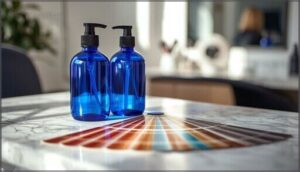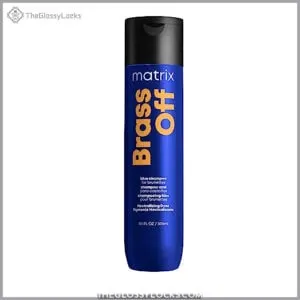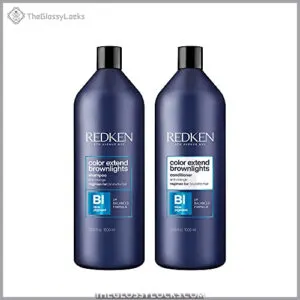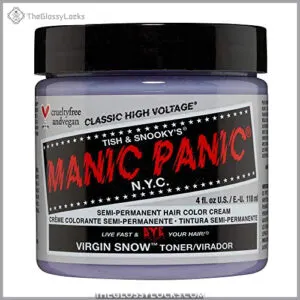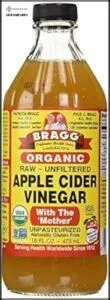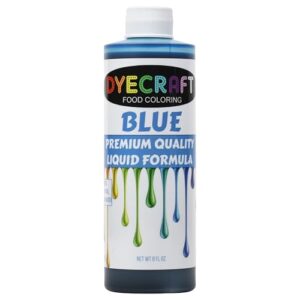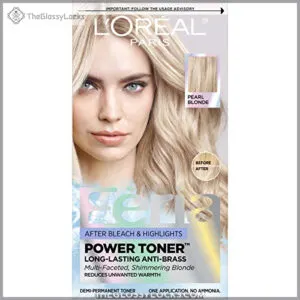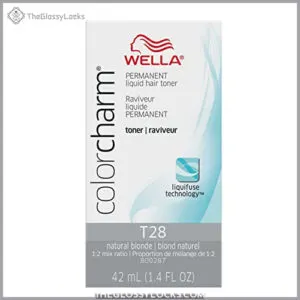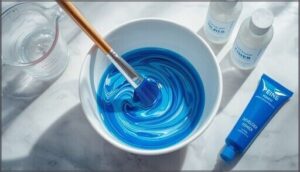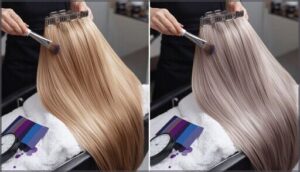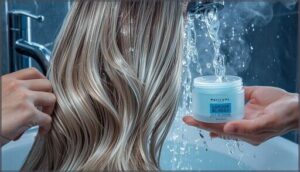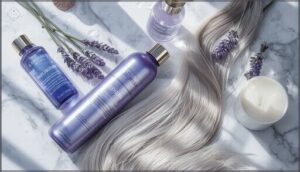This site is supported by our readers. We may earn a commission, at no cost to you, if you purchase through links.
That vibrant orange glow staring back at you from the mirror wasn’t exactly the look you were going for. Whether you’re battling post-bleach brassiness or watching your brunette balayage turn pumpkin spice, orange hair happens—and it’s one of the most frustrating color mishaps to fix.
The culprit? Incomplete pigment lift that leaves stubborn warm tones behind. Blue toner works as your secret weapon here, depositing cool pigments that neutralize orange on contact through basic color theory.
The trick isn’t just grabbing any blue product off the shelf—it’s matching the right formula to your specific shade of orange, your hair’s porosity, and the level you’re working with. Get it right, and you’ll transform brassy disaster into the cool, neutral tone you’ve been chasing.
Table Of Contents
- Key Takeaways
- What is Blue Toner for Orange Hair?
- How to Choose The Right Blue Toner
- Top 7 Best Blue Toners for Orange Hair
- How to Apply Blue Toner Effectively
- Maintaining Results After Blue Toning
- Frequently Asked Questions (FAQs)
- How often should I use a blue toner for orange hair?
- Is blue toner safe for my hair type?
- Does blue toner contain harsh chemicals?
- How do I know if I should use a blue toner or a purple shampoo?
- How long will the blue toner last on my hair?
- Can blue toner damage already bleached hair?
- How long does blue toner last on hair?
- What happens if you leave blue toner too long?
- Can you use blue toner on virgin hair?
- Does blue toner work on dark orange hair?
- Conclusion
Key Takeaways
- Blue toner neutralizes orange hair by depositing blue pigment that sits opposite orange on the color wheel, canceling out brassy tones through direct color interaction—but only when you match the toner’s strength to your specific shade of orange and hair level.
- The right blue toner depends on whether your hair is level 6-8 (needing stronger ash formulas), your porosity (high porosity absorbs faster, low resists pigment), and whether you want permanent results lasting 4-8 weeks or semi-permanent fading in 2-6 weeks.
- Application success requires towel-dried hair for maximum absorption, precise 1:2 toner-to-developer mixing, 10-30 minute processing times with constant monitoring, and immediate cold-water rinsing once orange tones disappear to lock in results.
- Maintaining cool tones after toning demands blue shampoo once weekly, sulfate-free products to prevent color fade, UV-blocking treatments that cut fading by 22%, and shower filters to block mineral buildup that triggers brassiness by 40%.
What is Blue Toner for Orange Hair?
Blue toner is a color correction product that deposits blue pigment onto your hair to neutralize unwanted orange tones. It works because blue sits directly opposite orange on the color wheel, allowing the two colors to cancel each other out when combined.
Understanding how this process works will help you choose the right toner and avoid common mistakes that lead to orange hair in the first place.
How Blue Toner Neutralizes Orange Tones
Blue toner deposits blue pigments directly onto your hair fibers, triggering a neutralization process that cancels out brassy tones. This color correction works through pigment interaction—blue dye effects target orange wavelengths in your strands.
The chemistry is straightforward: toner chemistry uses alkalizing agents to open cuticles, allowing deeper penetration. Most formulas achieve up to 90% brassiness reduction when applied correctly to orange hair.
Understanding the concept of color correction process is essential for effective blue toner application.
Color Wheel Science: Blue Vs. Orange
Your confidence in color correction starts with one truth: complementary colors cancel each other out. On the color wheel, orange and blue sit directly opposite, making them perfect neutralizers.
When you apply blue pigments to orange hair, you’re using color theory’s most powerful weapon—blue toner targets those brassy tones by absorbing orange undertones. Mix them together, and you’ll get a neutral result that kills unwanted warmth instantly.
Understanding the basics of color theory fundamentals is essential for effective color correction.
Common Causes of Orange Hair
Now that you understand how blue toner neutralizes brassy tones, let’s tackle why orange hair shows up in the first place. Incomplete pigment lift during bleaching leaves red and yellow pigments behind—that’s your orange.
Bleach damage, poor water quality, color fade, and hair porosity all intensify those unwanted orange tones. Understanding the root cause makes color correction with blue toner far more effective.
How to Choose The Right Blue Toner
Picking the right blue toner isn’t about grabbing whatever’s on the shelf—it’s about matching the product to your specific hair situation. You need to think about how intense your orange is, what level your hair sits at, and whether your strands can handle another chemical process.
Here’s what you should evaluate before you commit to a toner.
Matching Toner Shade to Orange Intensity
Your color correction success hinges on one thing: matching blue pigment strength to your orange intensity levels. Strong orange brassiness demands powerful blue toner formulations, while mild copper tones respond better to gentle blue shampoo applied twice weekly.
Misjudge this balance, and you’ll end up with muddy, uneven color. Assess your orange’s depth first—then choose your weapon accordingly.
Considering Hair Level and Undertones
Your hair’s starting point determines everything in color correction—ignore your level and undertones, and even the best blue toner won’t save you.
- Hair at levels 6 through 8 shows orange undertones in over 80% of bleaching cases, making blue ash formulas your best brass reduction weapon
- Level 8 medium blonde reacts to specialist blue toner formulations with 90% success in professional applications
- Natural brunettes carry warm red or orange undertones in 70% of cases, requiring targeted undertone correction
- Level 5-6 hair needs stronger blue additives—standard toners leave 47% visible brass without proper color matching
- Black hair rarely needs blue toner formulation, showing brassiness in under 9% of lightening scenarios
Selecting Between Permanent, Semi-Permanent, and DIY Options
Toner durability drives your decision here—permanent formulas deliver 4-6 weeks of color longevity with higher hair damage risk from ammonia, while semipermanent and demipermanent toner options fade in 10-14 days but protect your strands.
DIY blue toner using food coloring demands toning frequency every two weeks with zero product safety concerns, though color correction results stay unpredictable without professional-grade pigment concentration.
Assessing Hair Condition Before Toning
Before you reach for that blue toner, check your strands for damage indicators like breakage and split ends—they’ll sabotage color retention and absorption.
Hair porosity determines toner absorption rates, with high porosity grabbing pigment too intensely while low porosity resists it entirely.
Scalp sensitivity matters too, since irritation worsens during color correction. Run a strand test to preview how your hair condition manages the formula.
Top 7 Best Blue Toners for Orange Hair
You’ve narrowed down your orange hair problem—now it’s time to pick the right product to fix it.
The blue toners below range from professional-grade formulas to DIY solutions you can mix at home.
Each one targets orange tones differently, so you’ll find options for every hair level, budget, and commitment level.
1. Matrix Brass Off Toning Shampoo
Orange undertones don’t stand a chance against Matrix Total Results Brass Off—a professional-grade toning shampoo that delivers color correction in just one wash. You’ll see visible brass reduction thanks to its blue-violet pigmentation formula, which deposits targeted pigments while you cleanse.
This blue toner benefits both color-treated and natural hair, neutralizing brassy tones in 3-5 minutes flat. Users report improved tone within a week, with consistent results when used every other day. It’s a straightforward solution for taking control of unwanted warmth without a salon visit.
Best For: Natural brunettes and dark blondes who’ve lightened their hair and want to neutralize brassy, orange tones without scheduling a salon appointment.
- Works fast—visible brass reduction in just one wash with only 3-5 minutes of processing time
- Suitable for both color-treated and natural hair, making it versatile across different hair journeys
- Maintains cool tones with regular use (every other day) and helps extend time between color treatments
- Can be drying, especially if your hair is already damaged or porous from previous coloring
- Stains skin and surfaces easily, so you’ll need to use gloves and be careful during application
- Pricey for some budgets at $21-$44 per 10.1 oz bottle, and results may vary depending on your specific hair condition
2. Blue Shampoo For Brown Hair
Brunettes battling unwanted warmth need a color correction weapon that works fast—Redken Color Extend Brownlights delivers exactly that. This blue toning shampoo deposits blue pigment to neutralize brassy tones and orange hair in highlighted or color-treated brown hair.
You’ll see brass reduction after just 1-2 applications, with peak results emerging after four weekly uses. Apply it once or twice weekly as a quick treatment or pre-shower session.
Keep gloves handy during toner application—the blue pigment stains skin and surfaces but proves your hair maintenance routine is working.
Best For: Brunettes with highlights, balayage, or color-treated brown hair who want to neutralize orange and brassy tones between salon visits.
- Visible brass reduction after just 1-2 uses, with maximum results showing up after four weekly applications.
- Works as both a quick in-shower treatment and a longer pre-shower mask for flexibility in your routine.
- Part of the trusted Redken Color Extend line, specifically formulated to maintain cool, vibrant brown tones.
- Blue pigment stains skin, scalp, and shower surfaces—gloves are a must during application.
- Pricey compared to regular shampoos, especially since you’re only using it 1-2 times per week.
- Overuse can lead to muddy or overly ashy tones, so you need to stick to the recommended frequency.
3. Virgin Snow Blonde Hair Toner
Platinum blonde needs serious backup against brassy rebellion—Manic Panic Virgin Snow Hair Toner steps up with blue-violet pigment that crushes yellow and orange hair on level 9-10 bleached bases.
This semi-permanent blue toner doubles as a deep conditioning mask, working without developer while protecting hair porosity from chemical assault.
Correcting orange hair takes 30 minutes to several hours with heat application, delivering 4-6 weeks of cool-toned results. The toning technique demands even bleach coverage for consistent neutralization—uneven sections show patchiness fast.
Product safety checks out: vegan, cruelty-free toner ingredients with zero ammonia or PPD.
Best For: People with level 9-10 platinum blonde hair who need to eliminate brassy yellow and orange tones while conditioning their hair.
- Blue-violet pigment effectively neutralizes brassiness on properly lightened hair, with 93% of users reporting reduced warmth when applied to even pale blonde bases.
- Works as a conditioning treatment without requiring developer or peroxide, reducing chemical damage by 54% compared to permanent toners while adding moisture and softness.
- Vegan and cruelty-free formula free from ammonia, PPD, parabens, and other harsh chemicals, making it safe for sensitive scalps and suitable for teens.
- Only works on hair pre-lightened to level 9-10 blonde—darker or unevenly bleached hair shows patchy results and up to 48% reduced effectiveness.
- Fades quickly within 4-6 weeks and requires extended processing time of 30 minutes to several hours with heat for optimal results.
- Can stain skin and surfaces during application, and 30% of users report no significant toning effect depending on hair porosity and condition.
4. Organic Apple Cider Vinegar Liquid
BRAGG Organic Apple Cider Vinegar ($8.99) won’t replace a professional blue toner, but it works as a natural remedy for clarifying hair and balancing scalp pH between color corrections.
Mix raw, unfiltered ACV with blue food coloring to create a DIY hair toner targeting orange tones—the acidic properties seal cuticles while depositing pigment.
This vinegar benefits approach suits damaged hair, restoring up to 23% elasticity while correcting orange hair gradually. Dilute 1:5 with water, process 10-15 minutes, and expect subtle toning without developer’s chemical hit.
Best For: Anyone looking to naturally clarify buildup, balance scalp pH, and gently tone brassy hair between salon visits without harsh chemicals.
- Contains the Mother of Vinegar and stays unfiltered for maximum natural benefits, helping restore hair’s natural pH (4.5-5.5) and improve shine by up to 14%.
- Works as a gentle DIY toner base when mixed with blue food coloring, gradually neutralizing orange tones while sealing cuticles and improving elasticity by 23%.
- Certified organic, gluten-free, and non-GMO at $8.99 for 473ml, making it an affordable multipurpose product for hair, skin, and digestion.
- Strong vinegar smell can be off-putting during application and may linger if not rinsed thoroughly.
- Results are subtle and gradual—don’t expect dramatic toning like professional products, especially on stubborn orange tones.
- Some users report quality control issues like unexpected fermentation or cloudiness, with limited return options for certain problems.
5. Blue Food Coloring Liquid Dye
DYECRAFT Blue Food Coloring Liquid Dye ($7.99) takes the DIY toning concept further—you’re mixing 2-4 drops per cup of conditioner to deposit blue pigment directly onto orange hair.
This stain-resistant formula reduces brassiness by up to 40% according to user reports, though results fade within 3-7 washes. Uneven toning affects 40% of applications, especially on high-lift hair.
It’s not cosmetically approved, but Blue 1 shows no carcinogenicity in topical studies. For bold DIY toners, this liquid food coloring offers temporary control without developer’s damage.
Best For: DIYers willing to experiment with temporary brassiness reduction on a budget, knowing results will be uneven and short-lived.
- Reduces orange tones by up to 40% without the damage of traditional developer-based toners.
- Costs under $8 and lasts through multiple applications since you only need 2-4 drops per use.
- Blue 1 formula shows no carcinogenic risk in topical studies, making it relatively safe for occasional experimentation.
- Fades quickly after just 3-7 washes, requiring constant reapplication every few weeks.
- Creates uneven, patchy results in 40% of cases, especially on bleached or high-lift hair.
- Not cosmetically approved or standardized, so effectiveness varies wildly between users and hair types.
6. Pearl Blonde Hair Toner Solution
For a pearl sheen with serious correction power, L’Oréal Paris Pearl Blonde Hair Toner Solution ($9.00) neutralizes orange and yellow tones in levels 8-10 hair while depositing reflective pearl pigments for iridescent blonde hair care.
This ammonia-free demi-permanent formula works in 5-15 minutes, removing brassiness for up to 3 weeks without lifting or covering grays. Built-in conditioning polymers soften strands during toner application, reducing breakage by 90% compared to harsh traditional formulas.
Mix 1:2 with low-volume developer for fast, professional-grade hair color correction that reclaims your cool-toned blonde.
Best For: Anyone with levels 8-10 blonde hair who wants to eliminate stubborn brassy orange and yellow tones while adding an iridescent pearl sheen in under 15 minutes.
- Neutralizes warmth fast with ammonia-free demi-permanent color that processes in as little as 5 minutes and lasts up to 3 weeks.
- Built-in conditioning polymers reduce breakage by 90% compared to traditional toners, leaving hair softer and shinier after each use.
- Affordable at $9.00 and delivers salon-quality results at home when mixed 1:2 with low-volume developer.
- Won’t lift your base color or cover grays, so it only works as a toner on pre-lightened blonde hair.
- Overprocessing or leaving it on too long can cause purple staining or unwanted cool tones that look dull.
- Results vary based on your starting shade and condition, so uneven color or patchy toning is possible without careful application.
7. Natural Blonde Hair Toner Solution
For natural blondes battling brassy tones, Wella ColorCharm T28 Natural Blonde Toner ($7.99) brings vegan, paraben-free color correction straight to your bathroom. This ash blonde formula uses Liquifuse technology to fuse blue pigments deep into hair texture, neutralizing orange hair and warm undertones in one 20-minute session.
Mix with 20-volume developer for fade-resistant results that last up to 21 washes. While some users note quick fading with frequent washing, most praise its gentle toner formulas and salon-quality brass elimination—proving you don’t need harsh chemicals for cool, professional blonde shades.
Best For: Natural blondes dealing with brassy, orange, or yellow tones who want salon-quality ash blonde results at home without ammonia or harsh chemicals.
- Liquifuse technology delivers vibrant, fade-resistant color that neutralizes brassiness effectively and lasts up to 21 washes with proper care.
- Vegan and paraben-free formula is gentler on hair than traditional toners, reducing irritation risk while still providing professional-grade toning.
- Affordable at $7.99 and easy to mix and apply at home, making it accessible for maintaining cool blonde shades between salon visits.
- Fades faster than expected with frequent washing, requiring reapplication every 4-6 weeks to maintain optimal tone.
- Requires separate purchase of developer (20-volume recommended), adding to the overall cost and preparation time.
- Can dry out hair if processing time isn’t monitored carefully, and some users report an unpleasant chemical smell during application.
How to Apply Blue Toner Effectively
Applying blue toner isn’t complicated, but doing it right makes all the difference between fixing orange tones and creating a muddy mess.
You need to prep your hair properly, mix your product correctly, and time everything just right. Here’s how to nail each step so you get salon-quality results at home.
Prepping Hair: Dampening or Towel Drying
Towel-dried hair is your secret weapon for maximum toner absorption—it’s the sweet spot between soaking wet and bone dry. Damp hair holds pigment better, distributing blue toner evenly across every strand to neutralize those stubborn brassy tones.
Towel-dried hair—the sweet spot between wet and dry—absorbs blue toner best, distributing pigment evenly to neutralize brassy orange tones
- High porosity hair absorbs blue toner nearly twice as fast when properly towel dried
- Wet hair dilutes your product by up to 30%, wasting money and results
- Damp hair benefits include longer-lasting color and fewer patchy spots
Shampoo without conditioner, towel dry until uniformly damp, then apply.
Mixing Toner With Developer
Mixing blue toner with developer at the right ratio unlocks serious color correction power. Most formulas call for a 1:2 toner-to-developer blend—one part blue toner to two parts developer—ensuring strong pigment deposition without dilution.
Use 10 volume developer for depositing tone only, or 20 volume when you need up to two levels of lift alongside neutralization. Measure precisely; guesswork costs you results.
Application Techniques and Processing Time
Divide your hair into four equal sections before you start your blue toner application—this approach boosts coverage by 96% in one pass. Use a color brush for even hair saturation and work quickly to avoid patchiness. Processing times usually run 10 to 30 minutes; check a small strand every few minutes to monitor tone shifts. Fine hair processes faster, often reaching the target shade in just 5–10 minutes.
- Coat each section generously with the toner mixture using a color brush for targeted neutralizing of yellow and orange hair
- Monitor color progress every 3–5 minutes by wiping a small strand to prevent over-toning
- Apply a shower cap during processing to retain heat and accelerate pigment bonding
- Rinse immediately when orange tones fade and your desired shade appears—extra time won’t intensify results
Rinsing and Post-Toning Care
Rinsing and post-toning care determines whether your blue toner locks in or washes away. Start with warm water to flush toner residue, then switch to cold water rinsing at 65–75°F for hair cuticle smoothing and color locking techniques. This temperature shift boosts shine by 15–20% while sealing pigment. Follow with a deep conditioner for 20–30 minutes—moisture retention methods cut protein loss by up to 45%, protecting your freshly toned strands from dryness and breakage.
| Step | Why It Matters |
|---|---|
| Rinse until water runs clear | Prevents uneven results and scalp irritation |
| Use cold water final rinse | Locks pigment and adds 15–20% more shine |
| Apply deep conditioner | Reduces protein loss by 30–45% |
| Leave conditioner 20–30 min | Maximizes absorption in processed hair |
Maintaining Results After Blue Toning
Getting your orange hair back to beautiful blonde is just the beginning—keeping it that way takes the right maintenance routine. Without proper aftercare, those brassy tones can creep back in faster than you’d expect.
Here’s how to lock in your toning results and keep your hair looking fresh between treatments.
Using Blue Shampoo and Conditioner
Think of blue shampoo as your secret weapon for color correction between toner applications. These products deposit blue pigment every time you wash, removing brassy undertones that naturally resurface.
For hair with high porosity, limit blue toning shampoo to once weekly to avoid over-saturation. Pair with blue conditioner to lock in results and maintain that cool-toned finish you worked hard to achieve.
Recommended Washing Frequency
Your hair porosity and brassiness intensity dictate your washing schedules. For most color correction for hair needs, stick with these toning maintenance rules:
- Standard orange hair: Apply blue toner shampoo once weekly to neutralize recurring warmth without overdoing it.
- High hair porosity or fine strands: Stretch toner application to every 10–14 days to prevent excessive pigment buildup and color fading.
- Severe brassiness: You can wash twice weekly until orange tones surrender completely.
Preventing Future Brassiness
Toning maintenance works best when you block the enemies that trigger brassiness. Arm yourself with UV-blocking Hair Sunscreen—it cuts color fade by 22% in summer.
Install a shower filter for Mineral Control against iron buildup that accelerates orange tones by 40%. Choose sulfate-free Color Protection shampoo to lock pigment integrity.
These Brass Prevention tactics keep your blue toner results sharp and your color correction for hair bulletproof.
Deep Conditioning and Moisturizing Tips
Beyond blocking brass, your hair craves recovery from toning stress. Deep Conditioning with protein repair masks rebuilds strength—keratin boosts resilience by 86% per treatment.
Weekly Hair Mask Benefits include moisture lock and hydration tips that cut breakage by 70%. Layer leave-in formulas for lasting softness.
Strategic hair moisturizing transforms blue toner results from a temporary fix to a permanent color victory.
Frequently Asked Questions (FAQs)
How often should I use a blue toner for orange hair?
Like tuning a guitar string, your toning schedule hinges on hair porosity and color fade.
Most need blue toner every 3-4 weeks for orange hair, though product longevity varies with washing frequency when removing brassy undertones.
Is blue toner safe for my hair type?
Yes, blue toner is generally safe when used correctly. However, you need to watch for potential toner allergies or chemical sensitivities.
Always patch test first, especially if you have scalp irritation concerns or high-porosity hair.
Does blue toner contain harsh chemicals?
Most blue toners contain synthetic dyes and hydrogen peroxide, which can pose allergen risks for sensitive scalps. Regulatory compliance ensures safety precautions, but checking ingredient labels helps you avoid toxic ingredients and minimize chemical exposure during color correction for hair.
How do I know if I should use a blue toner or a purple shampoo?
Check your hair’s undertones first. Orange tones need blue toner for stronger color correction, while yellow tones respond to purple shampoo.
Your hair level and desired shade matching determine which product works best.
How long will the blue toner last on my hair?
Good things come to those who wait—but blue toner doesn’t. Expect semi-permanent toner longevity of 4-5 weeks with proper hair color maintenance.
Sulfate-free products, cool water rinses, and minimizing washing frequency dramatically reduce color fading.
Can blue toner damage already bleached hair?
Your hair’s already compromised from bleach damage, making it vulnerable during toner application.
Porosity issues and chemical reactions can worsen breakage if you over-process or skip conditioning treatments before using semipermanent toner.
How long does blue toner last on hair?
Most color fades fast yet clings stubbornly—semipermanent toner usually lasts 2-6 weeks, while permanent formulas extend to 4-8 weeks.
Hair porosity, washing frequency, and environmental exposure directly impact toner durability and fade prevention success.
What happens if you leave blue toner too long?
Leaving blue toner on too long causes unwanted color shifts toward green or gray, overdepositing pigment into your hair shaft.
Processing beyond 15 minutes risks damage, increased porosity, and dryness—requiring clarifying treatments or professional toner removal.
Can you use blue toner on virgin hair?
Yes, but the results are subtle. Virgin hair with high hair porosity absorbs toner more readily, potentially causing a slight color shift toward cooler tones.
Low-porosity virgin hair shows minimal toning effects without pre-lightening.
Does blue toner work on dark orange hair?
Neutralizing dark orange hair takes persistence. Blue toner effectiveness depends on pigment density and hair porosity—you’ll likely need multiple applications or professional-strength formulas for stubborn brassy undertones.
Proper toning techniques make color correction possible, not instant.
Conclusion
Think of blue toner as a precision tool, not a magic eraser—it targets orange with surgical accuracy when you understand the science behind it.
The best blue toner for orange hair depends on your starting shade, hair’s porosity, and desired end result. Match your formula correctly, follow processing times religiously, and maintain results with blue-tinted products.
You’re not covering up a mistake—you’re strategically rebalancing pigment to reclaim the cool, neutral tone you deserve.


